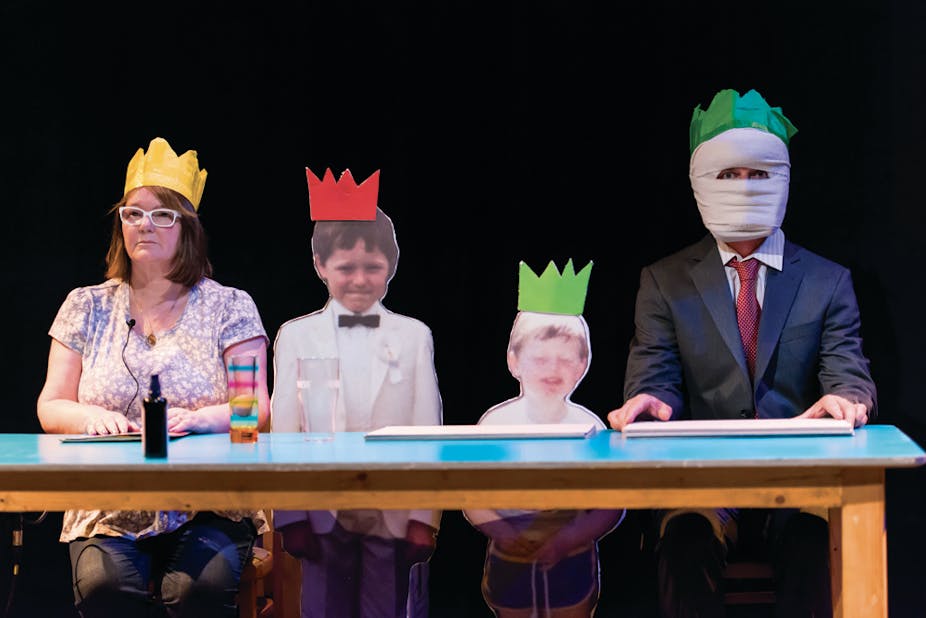Have I No Mouth, an Irish play showing at the Melbourne International Arts Festival, opens with a short video: a pint of Guinness on a tour of Dublin, Ireland.
It isn’t a glossy, tourist itinerary we see, but an everyday Dublin of local streets and family connections. Walking onstage, Feidlim Cannon, performer and co-director of Irish company Brokentalkers, introduces his mother Ann and psychotherapist Erich Keller, both playing themselves. Together they tell the story of mother and son as they struggle to deal with the loss of two Seans - newborn son and brother, as well as his namesake, the father and husband.
This is a very personal story, and it raises the longstanding question of the theatrical desire for “authenticity”.
Authentic theatre: a contradiction in terms?
The emphasis on authenticity, and the decision to cast two non-actors in the production makes us wonder whether there is a level of authenticity that a professional actor simply cannot achieve. Similarly, by playing themselves, the performers further distance themselves from the actor’s artifice.
Yet, despite stripping the Malthouse’s Merlyn theatre to its bare walls and a handful of props, the tightly directed, rehearsed and choreographed performance cannot disown its theatrical craft.
In a telling scene, Feidlim asks his mother to re-enact an argument she had with his father. She doesn’t, preferring to begin telling the story of their first date. Feidlim stands by, but gradually takes over this story, her story, not simply playing the angry, grieving son, but also artistic co-director, knowingly asserting control over the narrative.
Therapeutic theatre or theatrical therapy?
Erich Keller, real-life professional humanistic and integrative psychotherapist, plays a major role in the performance.
An unorthodox antagonist, Erich drives the narrative by coaxing both Ann and Feidlim to deal with their painful experiences. Their relationship is neatly illustrated by Erich’s opening request that they each think of objects that hold special memories.
Later, he dons a boxing helmet and wraps his head in bandages, standing in for Sean senior as they re-enact a family Christmas. During this role play, Feidlim transforms into a petulant child, demanding his proxy father play football, tickle him, hug him, hold him, and throw him in the air.
While Erich, with remarkable strength and stage presence, obediently obliges, none of it makes Feidlim happy. It finally breaks down, Feidlim’s anger and frustration creating an arresting spectacle as he turns to wrestle and dance violently with what is at once both the memory of his father and quite literally his psychotherapist.
Watching these scenes, one cannot help wonder: is this therapy as theatre for the audience, or theatre as therapy for Ann and Feidlim?
The difficulty of representation
In the opening scene, Feidlim shows us his tattoo; a black balloon with a string, tailing into an “S” to represent his brother and father.
The balloon hides an older tattoo, fallen from favour, of a Chinese character signifying baby brother Sean. Feidlim explores the struggle to represent his lost father and brother, be it with a tattoo, a pint of Guinness (his father’s favourite drink) or an obliging psychotherapist.
A recurring motif, the balloon returns when Erich addresses the audience to talk about safe and healthy anger management. He instructs us to take our anger, and blow it into the balloons we had been given when we entered the theatre.
He instructs us to let our anger out slowly, and we oblige, squealing and squeaking, turning our collective anger into light humour.
In the final scene, Feidlim takes an inflated balloon and and throws it in the air to Ann. They knock it back and forth, keeping it off the ground, and invite Erich, now de-masked, to join them. Together, they pass this weight between them, sharing it. This somewhat sudden, new-found healing is celebrated with a gloriously sensual (if conceptually confusing) final gesture.
The difficulty of representation never finds resolution in Have I No Mouth, speaking to the enduring difficulty of making sense of grief.
Resonating after the show, however, is the quiet, calm and healing presence of Ann, who never leaves the stage, but often slips quietly into the background. With her generosity to the audience, but in particular to her son, she gives new depth to the term “supporting actress”.
In a gentle yet dogged way her presence anchors this play. When Feidlim objects to Ann representing baby Sean’s coffin with a cardboard box, he tells her: “You could have represented him in a nicer way.”
Ann replies: “But it wouldn’t have been the truth”.
Have I No Mouth plays at the Melbourne Festival until October 13. Details here.

